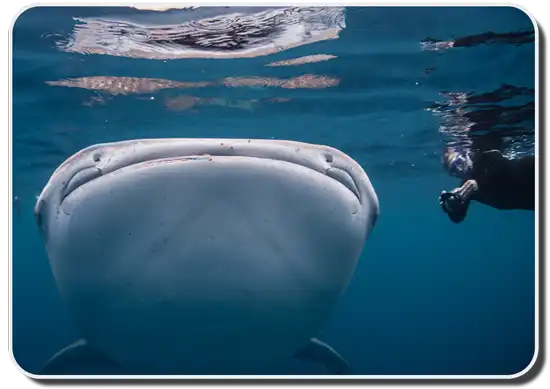Shark diets vary greatly among the 440 different species of sharks. Some sharks are fast aggressive hunters that eat large prey. While other sharks are slow moving filter feeders, and eat the tiniest animals on the planet. However, all sharks are carnivorous, which means they eat other animals, though they each has unique evolutionary adaptations to take advantage of their different food sources.

Sharks are considered apex predators because they have no natural predators. Unfortunately because of human activities like overfishing, industrial pollution, and habitat destruction, the marine food chain is threatened. So it is really important to understand what sharks eat in order to understand how we can protect their food sources so sharks do not face extinction.
Zooplankton
Zooplankton are tiny, microscopic organisms that drift in the ocean. Examples of zooplankton include fish eggs and juvenile fish, jellyfish, segmented worms, tiny crustaceans like shrimp, and larvae. Zooplankton is the primary source of food for filter-feeder sharks. Megamouth Sharks, Basking Sharks, and Whale Shark diets consistent entirely of zooplankton. Zooplankton travel vertically within the ocean, spending the days deeper in the water and at nights closer to the surface. Unfortunately, with the pressures of Global Warming and the increase in sea temperatures, zooplankton are spending more time close to the surface so they are being consumed at a much higher rate by fish, making it so filter-feeder sharks have to travel greater distances to consume the same amount of food.
Bony Fish
Some sharks like Blue Sharks, Bull Sharks and Dogfish Sharks primarily eat bony fish. Often times they eat the very same fish we do like Tuna, Grouper, Herring, Mackerel, and Anchovies. Some species like Hammerhead Sharks and Blacktip Reef Sharks will stalk and eat entire schools of fish, this behavior is commonly called a “feeding frenzy.” However, since we share the same tastes in fish, their food source is being threatened by humans. As commercial fisherman sometimes catch entire schools of fish, this depletes these shark’s food sources. In some places where there are no regulations, fisherman will overfish, leaving sharks in the region with nothing to eat, causing their numbers to decline.
Crustaceans
Another source of food for sharks are crustaceans like crabs, lobsters, shrimp, and krill. Crustaceans are hunted by a variety of sharks but most commonly they are eaten by bottom-dwelling sharks like Catsharks, Horn Sharks, Angel Sharks, Leopard Sharks, and Wobbegongs. Most sharks that eat crustaceans have biological adaptations like flatter teeth and strong jaws to crunch through the shells of these animals. However, several species of shark will eat crustaceans when there are no other options available. The biggest threat to crustacean populations is habitat loss and degradation from human activities. Like bony fish, they are also threatened by overfishing.
Sea Mammals
Sea mammals like walruses, seals, and sea lions are also hunted by sharks. Great White Sharks are the primary predator of sea mammals but other species such as Greenland Sharks and Tiger Sharks have been observed eating them as well. Sea mammals are an ideal food source for large predatory sharks because they have a very high fat content giving sharks much needed energy. However, sea mammals are also under threat from a variety of human activities. They are experiencing habitat loss and depletion, are often killed as a byproduct of commercial fishing, and are hunted and poached for their pelts. The loss of sea mammals in a major contributor to the declining number of Great White Sharks.
Seabirds
Seabirds are also eaten by sharks. They are a favorite of Lemon Sharks and Tiger Sharks. Great White Sharks also consume seabirds through a hunting technique where they jump up to 10 ft (3 m) out of the water to grab the birds right out of the air. Seabirds are one of the most vulnerable species to pollution and environmental degradation. Toxic chemicals, contaminants, and litter all pose grave threats to the populations of seabirds. Though seabirds are not a primary dietary source for any species of shark, the loss of seabirds puts more pressure on their other food sources. Without seabirds as a food source, sharks also lose an important component to their diet when their other food sources are low.
Garbage
Though the waste, garbage, and litter from human activities is not a part of any shark’s natural diet, in the last few years sharks have been dying in mass numbers from consuming waste that was mistaken for food. Sharks all over the world have been found with everything from tires to license plates in their stomachs to small bits of plastic. Shark tend to eat and swallow things whole, so often times they will consume a piece of garbage before realizing it isn’t food. This is a huge problem because with masses of pollution like the plastic gyres found in every ocean, sharks are increasingly more susceptible to eat waste products.
Shark Conservation: More Than Just Protecting Sharks
Over the years there have been some extraordinary efforts made for shark conservation. Several countries have designated conservation zones, banned shark finning, and even listed certain species of shark as “protected species.” However, without strong conservation efforts to protect the food chain of the sharks, even with the current protections in place, sharks will continue to face extinction. The ecosystem of the ocean is a delicate balance, so conservation efforts need to be comprehensive and protect the entire ocean in order to protect sharks.
So whether you are looking at the Great White Shark diet of sea mammals or the Whale Shark diet of zooplankton, it is important to understand how the environmental pressures on sharks’ food sources are impacting shark populations. Human activities that create pollution, destroy habitats, and reduce sea life populations, all have a negative impact on shark populations. So it is important that conservation efforts are inclusive.
